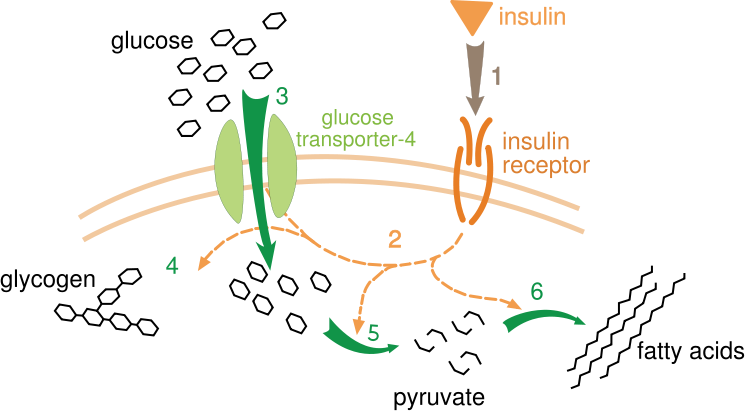GLUT4
| solute carrier family 2 (facilitated glucose transporter), member 4 | |
|---|---|
 Effect of insulin on glucose uptake and metabolism. Insulin binds to its receptor (1) which in turn starts many protein activation cascades (2). These include: translocation of Glut-4 transporter to the plasma membrane and influx of glucose (3), glycogen synthesis (4), glycolysis (5) and fatty acid synthesis (6). | |
| Identifiers | |
| Symbol | SLC2A4 |
| Alt. symbols | GLUT4 |
| Entrez | 6517 |
| HUGO | 11009 |
| OMIM | 138190 |
| RefSeq | NM_001042 |
| UniProt | P14672 |
| Other data | |
| Locus | Chr. 17 p13 |
GLUT4 is the insulin-regulated glucose transporter found in adipose tissues and striated muscle (skeletal and cardiac) that is responsible for insulin-regulated glucose disposal. It was discovered by Moris Birnbaum.[1]
Reaction to insulin
In the absence of insulin, GLUT4 is sequestered in the interior of muscle and fat cells.
Insulin induces the redistribution of GLUT4 from intracellular storage sites to the plasma membrane.
Once at the cell surface, GLUT4 facilitates the passive diffusion of circulating glucose down its concentration gradient into muscle and fat cells.
Once inside cells, glucose is rapidly phosphorylated by hexokinase to form glucose-6-phosphate, which then enters glycolysis.
Glucose-6-phosphate cannot diffuse back out of cells, which also serves to maintain the concentration gradient for glucose to passively enter cells.[2]
Pathway
The pathway in which GLUT4 is expressed on the plasma membrane begins with insulin binding to the receptor in its dimer form. The receptor phosphorylates and subsequently activates IRS-1, which converts PIP2 to PIP3. PIP3 is bound to PKB (protein kinase B), signaling for PDK1 to phosphorylate PKB. Once phosphorylated, PKB is in its active form and phosphorylates other targets that stimulate GLUT4 to be expressed on the plasma membrane.
Contraction
Contraction also stimulates the cell to translocate GLUT4 receptors to the surface. This is especially true in cardiac muscle, where continuous contraction can be relied upon; but is observed to a lesser extent in skeletal muscle. [3]
References
- ↑ Birnbaum MJ (1989). "Identification of a novel gene encoding an insulin-responsive glucose transporter protein". Cell. 57 (2): 305–15. PMID 2649253.
- ↑ Watson RT, Kanzaki M, Pessin JE (2004). "Regulated membrane trafficking of the insulin-responsive glucose transporter 4 in adipocytes". Endocr. Rev. 25 (2): 177–204. PMID 15082519.
- ↑ Lund S, Holman GD, Schmitz O, Pedersen O (1995). "Contraction stimulates translocation of glucose transporter GLUT4 in skeletal muscle through a mechanism distinct from that of insulin". Proc. Natl. Acad. Sci. U.S.A. 92 (13): 5817–21. PMID 7597034.
External links
- GLUT4+Protein at the US National Library of Medicine Medical Subject Headings (MeSH)
| Stub icon | This biochemistry article is a stub. You can help Wikipedia by expanding it. |